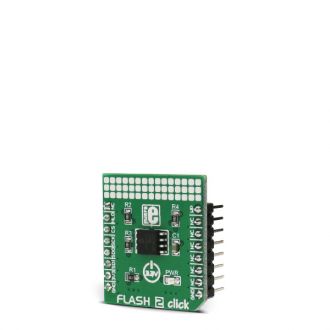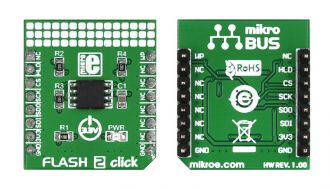
We strongly encourage users to use Package manager for sharing their code on Libstock website, because it boosts your efficiency and leaves the end user with no room for error. [more info]

Rating:
Author: MIKROE
Last Updated: 2018-03-13
Package Version: 1.0.0.1
mikroSDK Library: 1.0.0.0
Category: FLASH
Downloaded: 7561 times
Not followed.
License: MIT license
Flash 2 click is a mikroBUS add-on board for adding more Flash Memory to your target board microcontroller. It carries Microchip’s SST26VF064B flash-memory module with 64 Mbits capacity. It’s a highly reliable module with a specified minimum of 100,000 read and write cycles and with over 100 years of Data Retention.
Do you want to subscribe in order to receive notifications regarding "Flash 2 click" changes.
Do you want to unsubscribe in order to stop receiving notifications regarding "Flash 2 click" changes.
Do you want to report abuse regarding "Flash 2 click".


Key functions:
Examples Description
The application is composed of three sections:
void applicationTask()
{
mikrobus_logWrite("Writing MikroE to Flash memory, from address 0x015015:",
_LOG_LINE);
flash2_write (0x015015, &wrData[0], 9);
mikrobus_logWrite("Reading 9 bytes of Flash memory, from address 0x015015:",
_LOG_LINE);
flash2_read(0x015015,&rdData[0],9);
mikrobus_logWrite("Data read: ",_LOG_TEXT);
mikrobus_logWrite(rdData,_LOG_LINE);
Delay_ms(1000);
}
Other mikroE Libraries used in the example:
Additional notes and information
Depending on the development board you are using, you may need USB UART click, USB UART 2 click or RS232 click to connect to your PC, for development systems with no UART to USB interface available on the board. The terminal available in all MikroElektronika compilers, or any other terminal application of your choice, can be used to read the message.